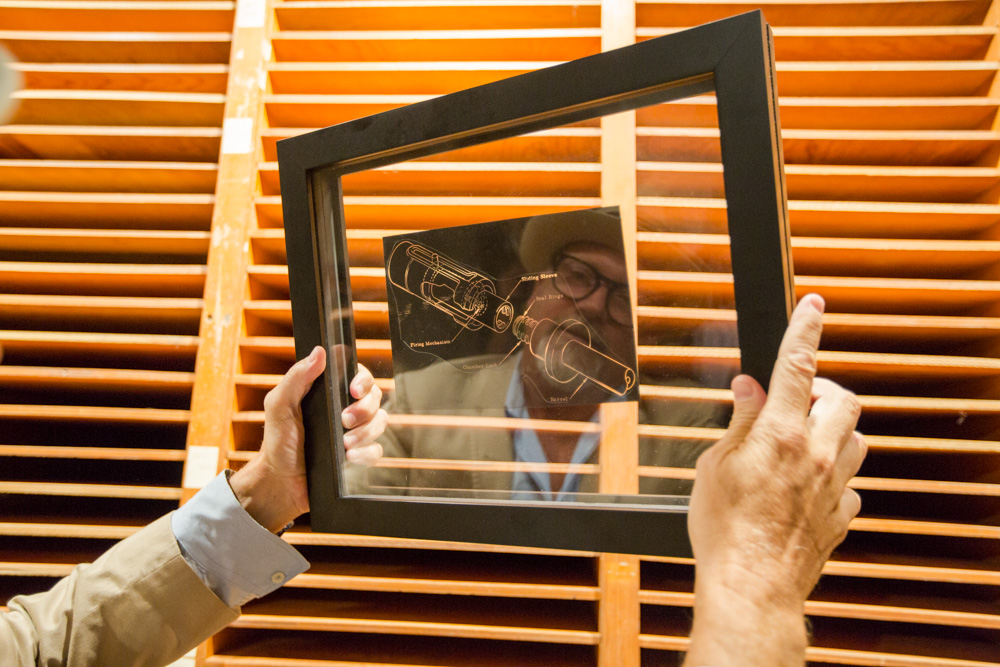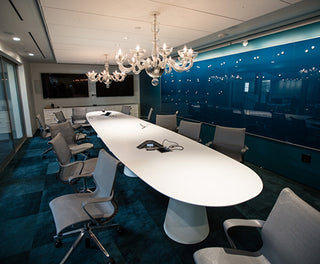Advertising seemed like a good backup plan. If I never made it as an artist, Advertising looked like the appropriate space to fill. It was creative and idea-driven, and I sorta liked the thought of having a cool stable job, the reliability of a 9-5 with a desk I could call home, coming up with smart posters for a soft-drink company that made people laugh.
But the more I explored the Advertising world in college, the less it appealed to me. It erred too much on the side of corporate, less on personal creative freedoms. Frankly, it seemed largely soulless and processed. Advertising couldn’t just be about Selling, right? Wasn’t it supposed to be about relating?
72andSunny‘s been coming up a lot lately. Although they’ve been around for 10 years, it seems now more than ever, their agency has become the zeitgeist – not as to what Advertising is, but what it should be. With offices in Los Angeles and Amsterdam, their radical approach to a stale and stodgy form has won them critical acclaim (2013’s Agency of the Year, by AdAge and AdWeek) and rapid growth. Meanwhile, the general public gobbling up 72andSunny’s Samsung, Carl’s Jr., and Google campaigns have nary a clue as to the inspired minds behind them. Suddenly, Advertising doesn’t seem so unfavorable and orthodox. From their brand new headquarters in Howard Hughes’ old offices right off Silicon Beach, I sat down with founders and partners Glenn Cole, John Boiler, and Matt Jarvis in the late aviation mogul’s patents vault (now conference room).
As their name suggests, the future of Advertising’s looking promising.
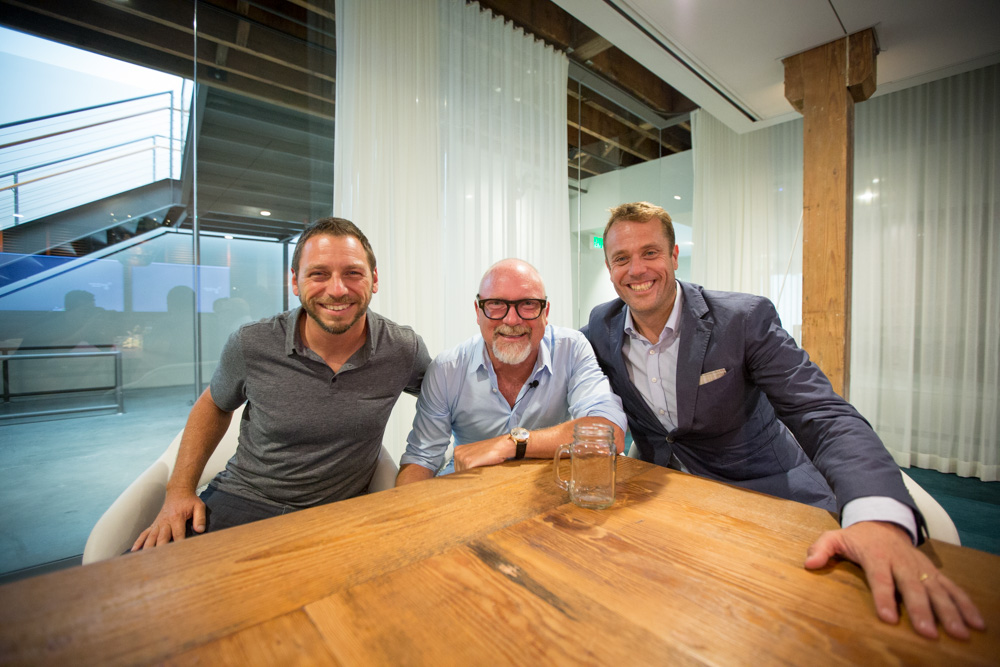
Me: I think we should begin by talking about this building and where we are right now. Why you chose a space like this and how important it was for the genesis and development of 72andSunny.
John: We’ve always been kind of attracted to the hidden forgotten corners of LA. Glenn and I came upon this joint kind of by accident. We were looking around and it was just a dirt lot by these two buildings. We were told by the agent at the time – this building had all its windows broken out and there were people sleeping in it – but we just loved the building. It was all wide open, super industrial, kind of reminds me of Bauhaus architecture; all glass box.
So that attracted us to it eventually and later when we found out it was the historical Hughes aircraft offices, including the office of Howard Hughes himself. Then that was just –
And how many years ago was that?
John: When we discovered it, it was three years ago.
So this is all relatively new. I thought you guys had been here for a long time.
John: No, we just moved into this side. I think, three weeks ago?
And the company itself, it started, roughly, a decade ago now? Is that right?
John: 2004.
In Amsterdam?
John: Simultaneously in Amsterdam and LA. One of our other partners, Robert Nakata, we had worked with before and he lives in Amsterdam. And we also had a lot of clients from working there previously that we wanted to stay in touch with so we simultaneously opened two doors at once.
Matt: Amsterdam is such a great design hub. People move there from all over the world, so from a talent standpoint, having a presence has been significant even as a small company doing global work; things that feel like it lives beyond American borders and has more of a global sensibility. Which has been the – I think – hallmark of our business when we’re doing it right.
Let me take it back to the beginning of 72andSunny. So for my company – and we’re a clothing brand – but we were fans, first and foremost, of other brands that I’ve grown up on. Then when it came time for me to create my own project, it was developed as a response. It was a way for me to – more or less – fight back and also have my voice heard in that space. And for some reason, I feel like there is a parallel with 72andSunny.
I know, for the most part, that you guys came from the Wieden+Kennedy world and learned under their auspices but do you think it was a response to the traditional advertising game? And that’s also why there’s been so much traction with 72andSunny?
John: I think that’s really insightful, a lot of the reason 72andSunny came into being – including its name – was a reaction to what the industry was. In our minds, the industry had, in some ways, become kind of cynical, very ego driven, and not very collaborative; did not work or play well with others. And we were looking for a more sustainable way for our lives to be lived. Because living in a cynical ego driven environment takes its toll on you and ultimately is kind of going to grind you down.
So 72andSunny, even in the name, is an expression of optimism and recognizing the opportunity that’s out there in front of us. And we just thought we could build something that we’d want to live in; build an environment that was a reaction to that. And it has resonated with all our clients. They love our collaborative nature. We’re not threatened, we tend to be pretty fearless but also pretty generous. We don’t mind playing with other agencies and other partners and brands. That’s kind of the modern way of doing any business these days.
Is the ego still there?
Matt: Of course, we’re humans. But you just want to have a healthy relationship with it. We’re trying to enjoy creativity and be great at it in service of our clients and ourselves – so we all have egos but when they’re running us it gets in the way of creativity. And we’re all about great creativity. We have to make the commitment to work really hard to not let that happen.
How important is it for you guys to be marketing the 72andSunny name in and of itself? Is that a big part of what you’re about?
Matt: It’s not something that we’re super conscious of. We believe in the idea – it’s a company but it’s also an idea – about being positive and optimistic. And so I think we spend more time trying to be it and working on that aspiration. There are certainly days when we come up with a handful of mud like everybody else, but we try really hard to be it and then let that become the marketing in itself.
We have 400+ people that we interact with everyday and those are the most important people that need to believe in 72andSunny and care about it and get something out of it.
There’s 400+ people in the building?
John: Yes, in this area. And then we have another 90 in Amsterdam.
I like that you’re talking about how they are happy and enjoying their work here. That’s evident in walking through the building. There’s no way that anyone can complain about their job.
Matt: [Laughs] From your lips to God’s ears.
John: Strangely, we can always find something. [Laughs]
Matt: I think that our culture – that’s our secret sauce – and culture is a daily habit. Just because we were awesome yesterday or last week, we gotta be awesome today. So keeping our eye on the culture – ultimately – that’s our North Star, that’s how we make our business decisions; that’s how we make all of our decisions. We believe that when you have a healthy culture, things tend to work out well. And if they don’t work out the way you wanted them to work out necessarily, you can still live with it. Because you’ve been honest about what you’re trying to be.
How involved are you guys, still, in the business? Especially at this level in the game, in most businesses, guys like you are pretty much just a face and nothing more…
Matt: [laughing] No, no, there’s still dirt under these nails.
John: I was doing PDFs last year. I think that’s a really important part of the culture: being a doer and a maker all the time. And we really place high value on continuing to do that because otherwise, if you’re not making the donuts, you don’t learn who the great people are, you don’t know what’s happening. So we’re keeping the mud under the nails.
Matt: I think about places I’ve worked where people – at some point – stopped doing the work, never agreed with me. I always had more respect when I was coming up for my bosses who I saw really being great at the craft or great contributors. It’s something that we all place a high value on.
Where do you look for inspiration?
Matt: I get a lot of inspiration from my teammates. These guys, people we work with, I think that’s one of the great things about being able to come to work here. There are a lot of people to be inspired by.
Glenn: Same answer. I get all the inspiration from the people here. That’s the juice, showing up everyday. It’s exciting because you’re learning every time, but I feel like there are more people that show up with skills that either I don’t have – or I never even knew was a skill you could have – or a lateral way of looking at something that I wouldn’t have thought of. There’s once or twice a day where I’m like, “Holy shit that’s awesome. I never would’ve seen the world that way or that problem that way or that edit or picture or just people that way.”
John: Just to have a different-er answer – because I agree with that as well – but I’m also really inspired by –
Glenn: …Horror movies.
John: …Yes!
Glenn: [Laughs] It’s a mad lib.
John: Zombies, vampires – No, they started calling this place Silicon Beach, right? I think that a lot of inspiration for me comes from watching the way other businesses – both creative and technology – behave. Fundamentally they’re people businesses like we are. It’s a talent business, but they just do it a little bit differently. I think a lot of our daily behaviors have been inspired by what we’ve seen happening. Rapid iteration, don’t be precious, get the beta out there, fuck things up, do it again. So I think we take a lot of inspiration just from other industries that are doing things differently.
How do you source your talent?
Matt: First and foremost, we’re very inspired by training and growing people and the farm system and just unleashing interesting people on problems and getting fresh takes on it. I think, ultimately, what we look for are interesting people who have done interesting things. You could have never left LA and lived that life, or you could have traveled all corners of the world and not met that criteria.
It’s really an orientation about people who want to learn. Certainly their skills and talent along the way all count, but there’s probably a lot of talented people out there who wouldn’t be good fits here. Because they wouldn’t be additive to the culture and some of the greatest satisfaction is taking some of the people who are fits and teaching them the craft.
John: I think we’ve got three ways of doing it. We’ve got recruitment, we’ve got training (so 72U, our in-house schools and other ways of reaching into education) and pulling up people that way. But really, my favorite is networking. The cool people that took a long time to get in here bring their own networks of other awesome people. I’m pro nepotism!
Glenn: A lot of people who stuck are people who found us. We didn’t find them. They came and came and came and there’s a lot of people here whose background I don’t know now that you’re asking. I’m going through industries. There’s entertainment, there’s technology, there’s advertising, production, education… we have a surprising amount of people that come from education, theater.
Some stranger than others but a lot of those people found – probably in recent years – us, which is really gratifying. I think all the people who got in the door did so by tenacity. I think that’s almost our favorite calling card. If you keep coming and you want it bad – if you want it bad you’ll bust your ass, and if you bust your ass that’s all we’ve ever done to get good. We’re believers of “If you go at it hard enough, the right answer will emerge.” I don’t know if you call that recruitment or finding talent, but maybe it’s being open to the talent that shows up and demands to get heard.
Matt: One of our philosophies is “Grab an oar” if you see the boat and there’s an open seat and an oar. Don’t wonder who’s going to pick up that oar, just go pick it up. And that orientation is really good for people who are living on the front foot. If you come in here and you’re in a grab-an-oar environment, then sometimes it doesn’t matter if you’re the most experienced or whatever. You’re there and you’re willing to be a good teammate and I think that’s kind of it. That’s how we fall in love with people and how we develop these relationships that people stay in for a while.
And how do you find your clients? Who do you say no to?
Matt: Well, we want to work with people who inspire us and that we think we can do a good job for. We’ve got a high hit rate and one of the reasons is because we tend to have great clients that we’re working with.We can be as good as we can be, but without a great client it doesn’t really go anywhere.
So we look for people that we want to be in business with, people that inspire us, business opportunities, and then I do think we do like ambition. We’re ambitious, we want to get on the big stage, we don’t want to play on the side stage. And so that’s a little bit of our company’s personality; we look for that too.
Glenn: It doesn’t have to be a giant client. Whatever size they are, they have wildly ambitious and audacious goals. I think that’s a top two filter. I think there are some logos on our list of clients that immediately make sense, there are a few that you look sideways at, or you don’t look sideways at now but you might have on the first day. But our job is to turn them into clients that later are the category buster – everybody-talks-about-them brands.
Can we talk about Samsung versus Apple? Is that something we can talk about?
Glenn: We can talk about Samsung. [Laughs]
Let’s talk about Samsung.
I’ve been on my Samsung for two years and finally I feel like there’s some current there. I feel like a large part of that has to do with you guys and what you’ve done with the campaign and obviously the commercials. The Jay-Z thing was a big one too. Why did you take them on as a partner? What is your strategy? And do you feel like you have succeeded in that space?
John: I think it’s a great example of what Matt was saying in terms of the human being – The partner that we have at Samsung, we just have enormous trust with, and respect off the bat because we work with them. His name is Todd Pendleton and he was at Nike so we were working with him there. He moves down to Samsung and he called us and was like, “I just need some help to get this thing really rocking. We’ve got the best phone, nobody knows it.”
They weren’t even on the consideration chart when he got there and he just recognized that there was a huge opportunity. How can we steal the cultural conversation? So to Glenn’s point, crazy high ambitions. It was just like, “I expect us to be the number one in a couple years,” and that was laughable at that point.
So we had those two great ingredients and the third great ingredient was high pressure. We had to get something in market in a number of weeks. We had to get concepts to him in four days and we had to produce it in two weeks. So high-stakes, high ambition, great talent, great partnership, and lots of trust yielded some powerful work because there’s nothing about that process that’s conventional advertising. It was like he knew what the product was. He knew what the proposition was. We got it, and we nailed it out of the gates because we were fighting mean and lean.
And we’ve continued that cadence because in the technology sector, you have to move fast. So we’re acting pretty instinctively all the time. But because we’re so close to the market, we’re really in it and recognize what people are digging about the phone or what they want to hear. That allows us to do these things.
“The next big thing is here” is the line that we launched in 2011. That line has really served as a guide post for us in all our marketing so if anything we’re about to do next feels like something we did last, we’re not going to do it. That Jay-Z thing was a great example of what has never been done or even attempted in a partnership with an artist bringing a new album to the floor. So we invented that because it had never been done before and Jay was into it, “Okay, yeah I want to be the first to sell a million albums in a day.” [laughs]
Matt: …before it’s launched!
Do you feel like – I guess I can say Apple – but the other phone companies are feeling the heat from that?
Matt: You’d have to ask them.
Glenn: It’s a different financial landscape than it was when we started, that’s for sure. In terms of sales and market share, we were iPhone guys when that thing started so I think it was a very empathetic approach. We started with, “Okay, we’re going to have to look in the mirror here and convince ourselves.” And then convincing ourselves starts with mocking ourselves. [Laughs] I think that was the genesis of that first thing: we were the guys waiting in that line. There was one day where we were like, “What the hell are we waiting in line for? We’re waiting for this thing?”
So I think it came from a pretty organic honest place, but also a personal place for us. I guess people are projecting themselves into it too.
What makes a great advertisement or ad campaign?
Glenn: Large logo, that 24 seconds of content with product. No I’m kidding. [Laughs]
Matt: Telling the truth. You can’t pull the wool over peoples’ eyes; the saying, “Truth rings a bell.” And I think one of the most cutting comments on creative work here is if in a review, someone says, “I don’t know if that’s true,” you can just see it lose altitude immediately. So that’s not enough, but if you don’t start there, it’s tough. It’s tough to get peoples’ respect.
Glenn: I think most great ads are like a dance. Ultimately our job is to strengthen the relationship between a brand and a person; me, you. The ad is just one song in the line of dancing but you have to leave room for each of you to do your thing. There has to be a little give, a little take, there has to be room for you to project yourself into it or interpret it… has to respect you… in the morning [laughs].
But I look at it that way so at least when I try to have any influence on the work here, it’s usually to get a conversation going and make something that feels like there’s give-and-take between the person on one end and then the brand on the other.
Matt: Good music helps.
I feel like 72andSunny comes up in conversation a lot now. Even compared to a year ago. From unexpected places too. I’ll be out at a bar, I’ll be with friends around dinner and it’ll come up, which is great –
John: Yeah, I’d love to know the context. [laughs]
It’s always a good thing. I just feel like it happened so fast. I mean, 2004 until now, that’s not a lot of time. How does that feel for you guys?
John: It didn’t feel fast enough. [laughs] It was like dog years. Every night and weekend.
Glenn: I feel the same with The Hundreds actually, in sort of a similar time horizon if I think about how long you guys have been around. So I’d ask you the same question just out of curiosity. But for us, in some ways it’s been awhile, it feels long, but there has been a lot of energy lately.
I feel like the values of the place and of the people who are here now, are really in sync with key cultural values; openness, collaboration, social change for good, getting each other’s backs. I think that’s what’s on the rise culturally/globally and we founded the company on those principles as a way of working together with clients. To create better work and have a better experience for the 60 hours we’re awake doing it. But I feel like those corporate values and the cultural values are really aligned right now. But that’s a guess.
Part of it is also luck and karma. [laughs]
From an outside point of view everything that you just said seems right. That’s what it feels like to me.
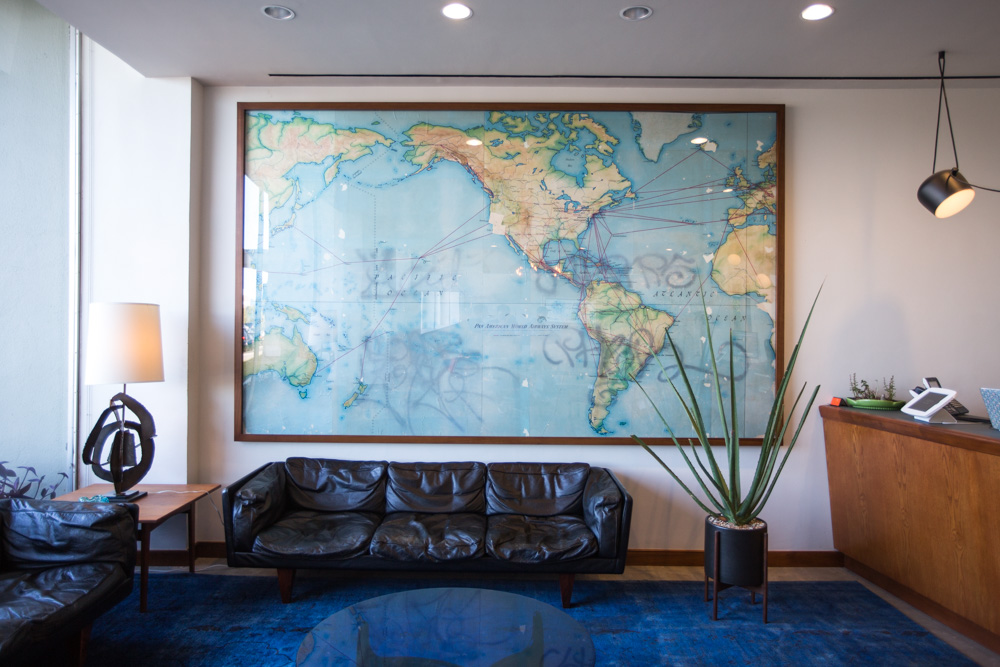
Lots of cool art installations throughout the buildings, which accommodates the inspired energy:
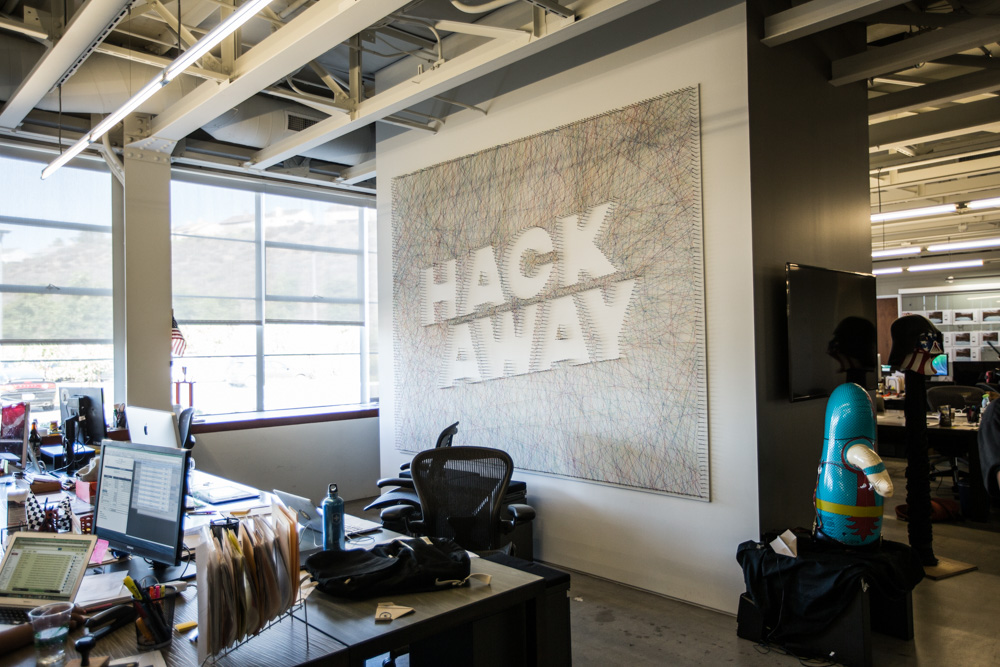
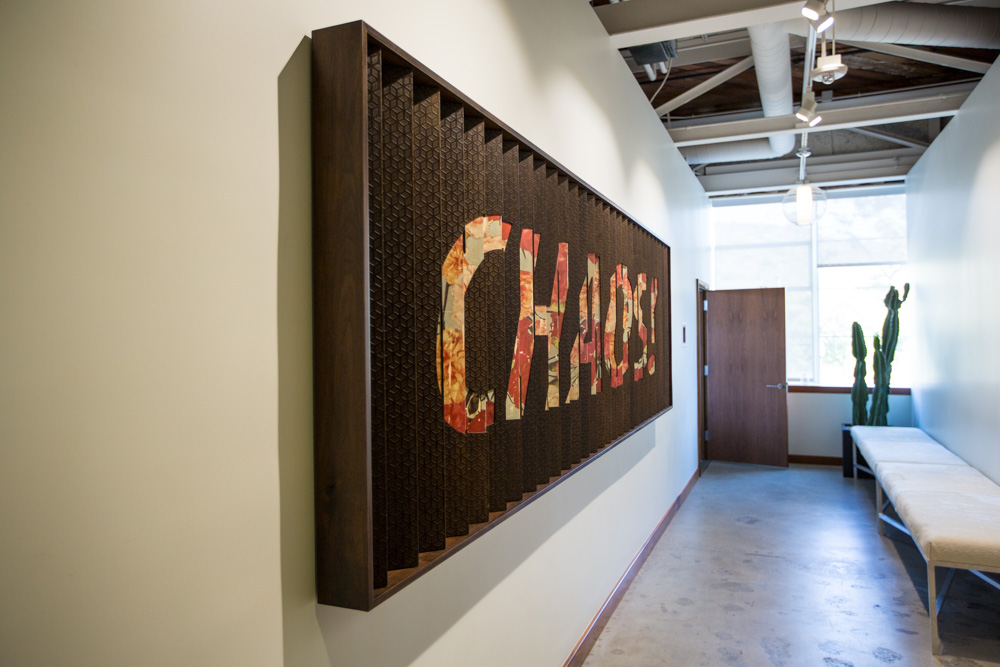
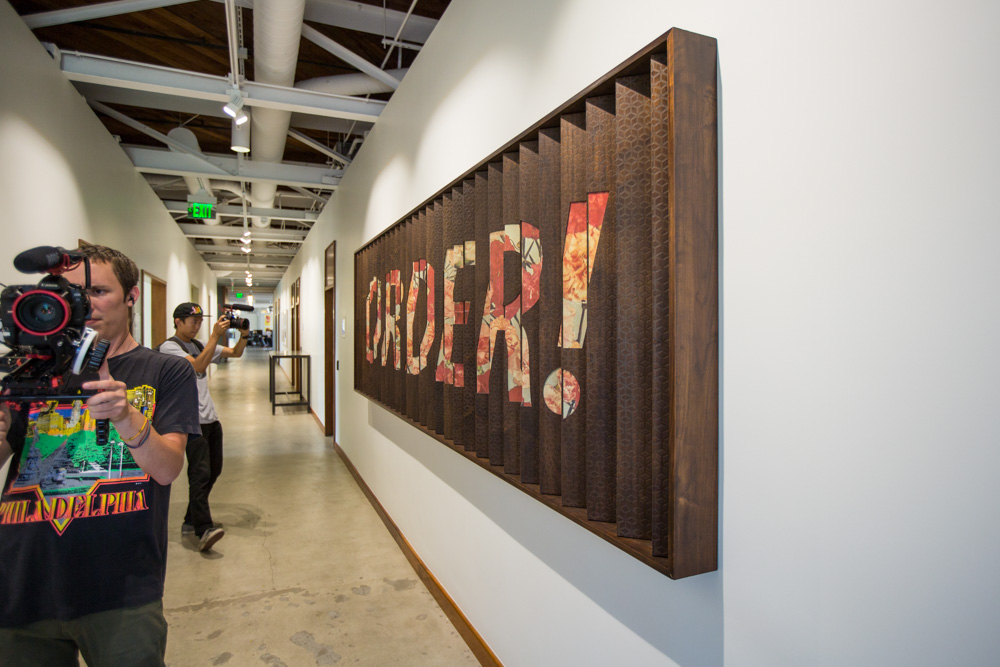
Howard Hughes’ original office:
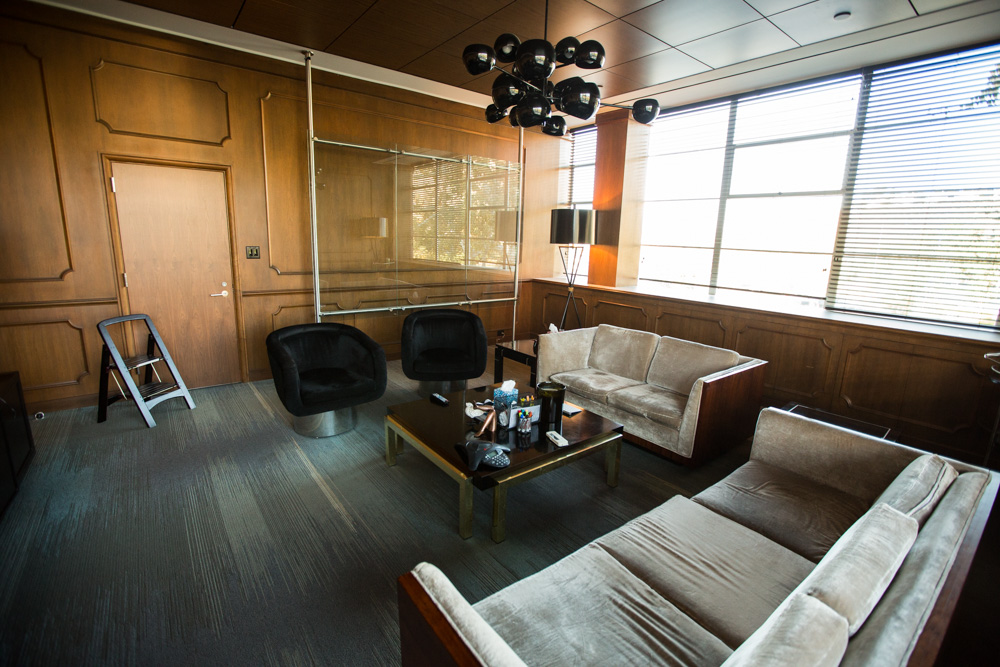
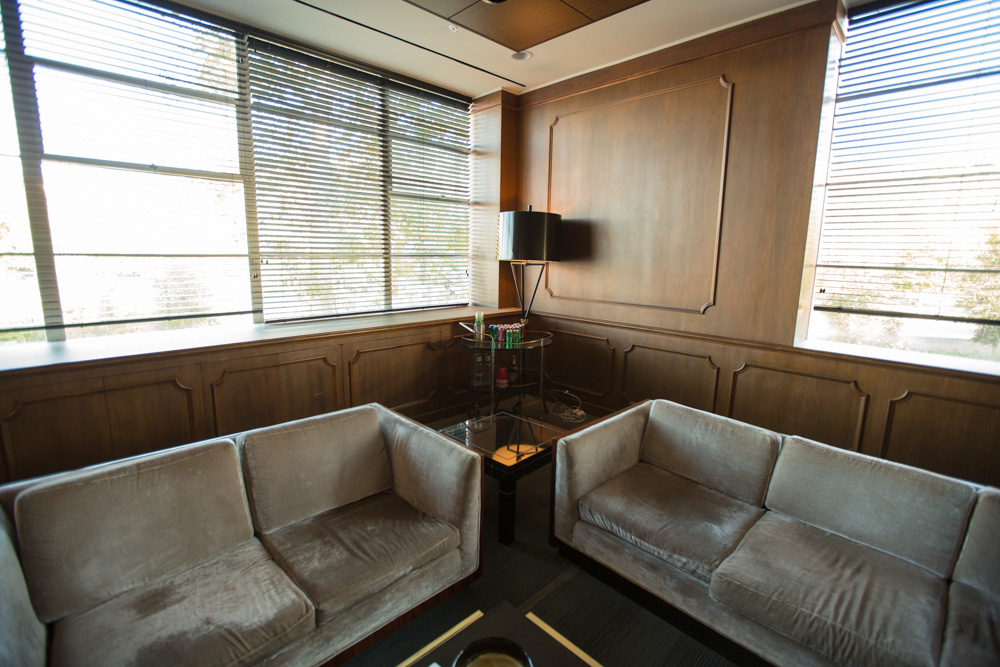
Because of the aviator’s aversion to hallways, the office rooms are connected with a channel of doors:
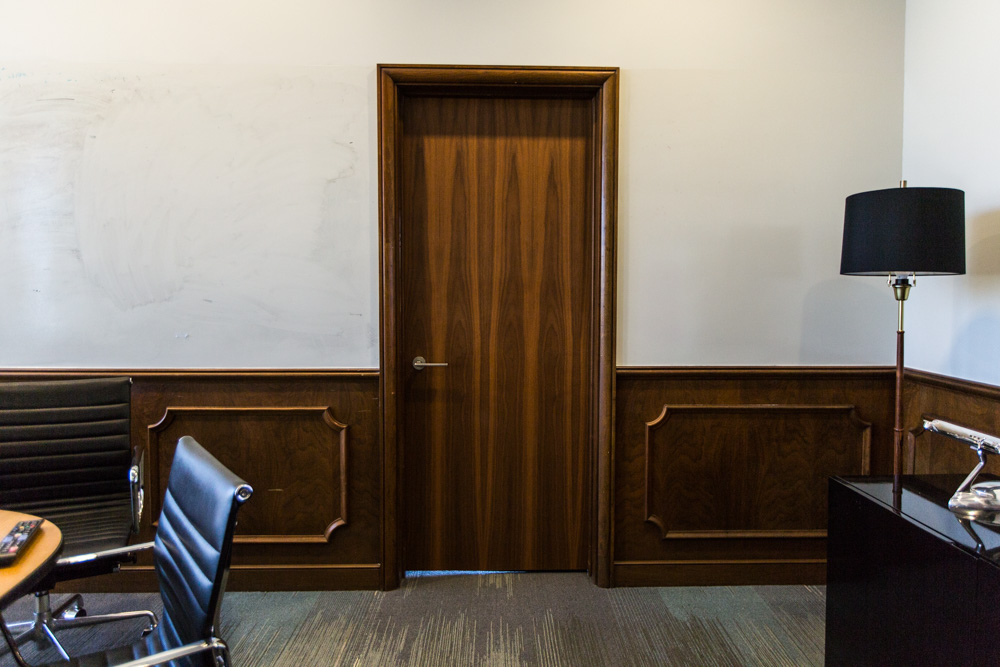
The bosses’ office is open and obvious, centrally located, and inviting for staff to enter:
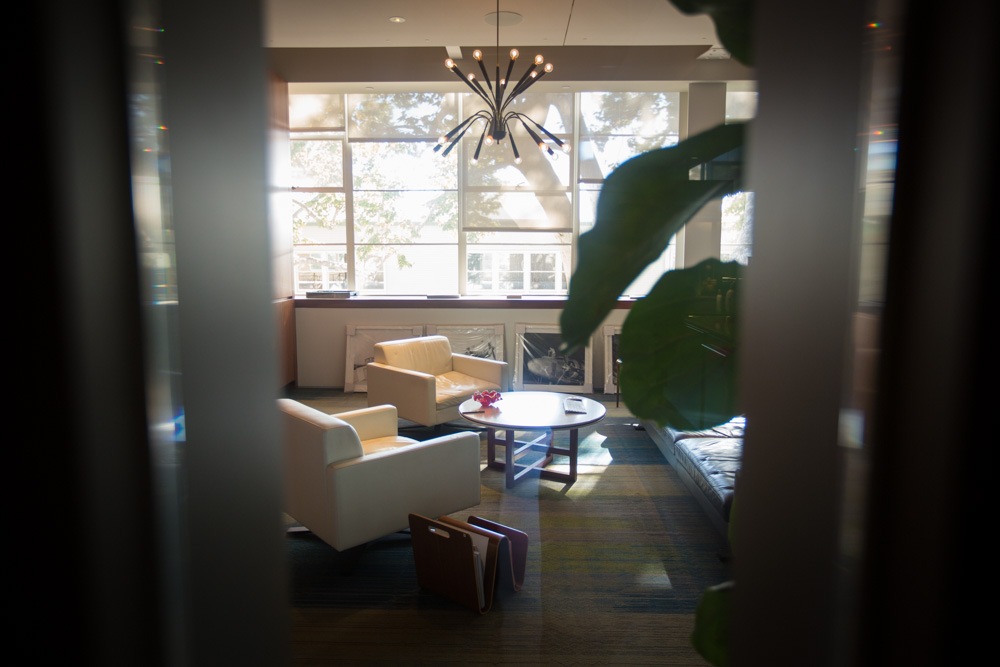
Teams are broken up between responsibilities and clients. Everyone is allowed to bring their dog to work, a policy that has existed since the company’s inception.
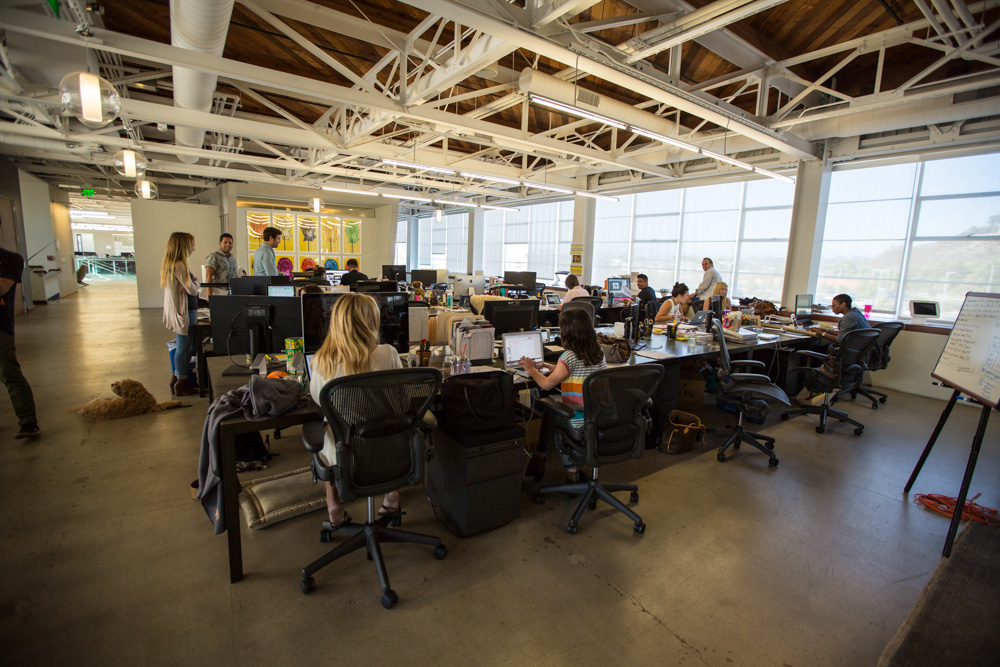
You’re not restricted to a desk or traditional quarters. Staff are encouraged to take advantage of the multiple lounging areas, or even venture outside to get work done.
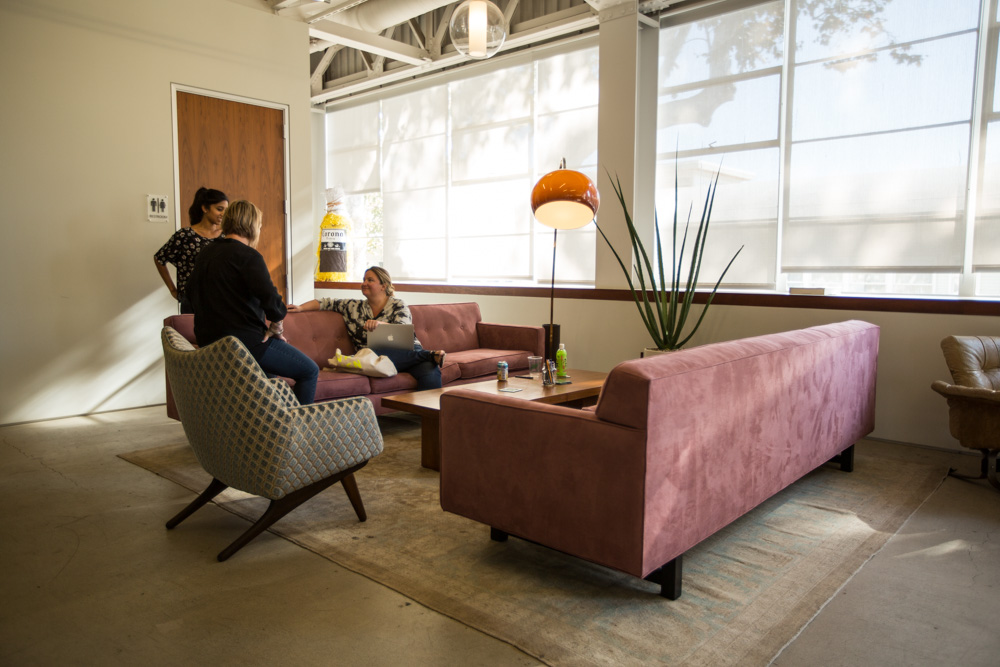

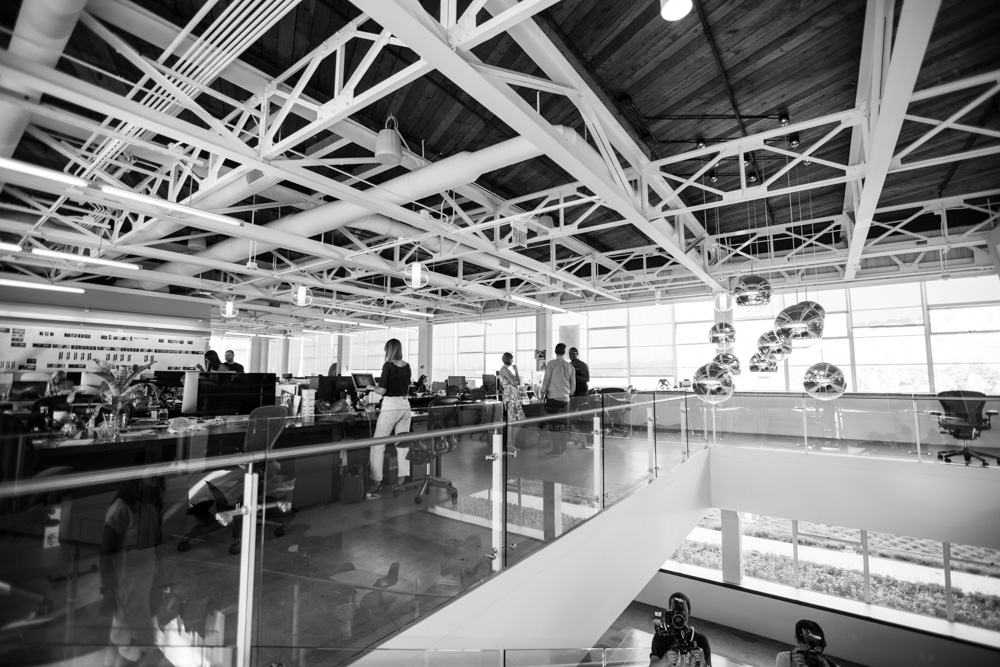
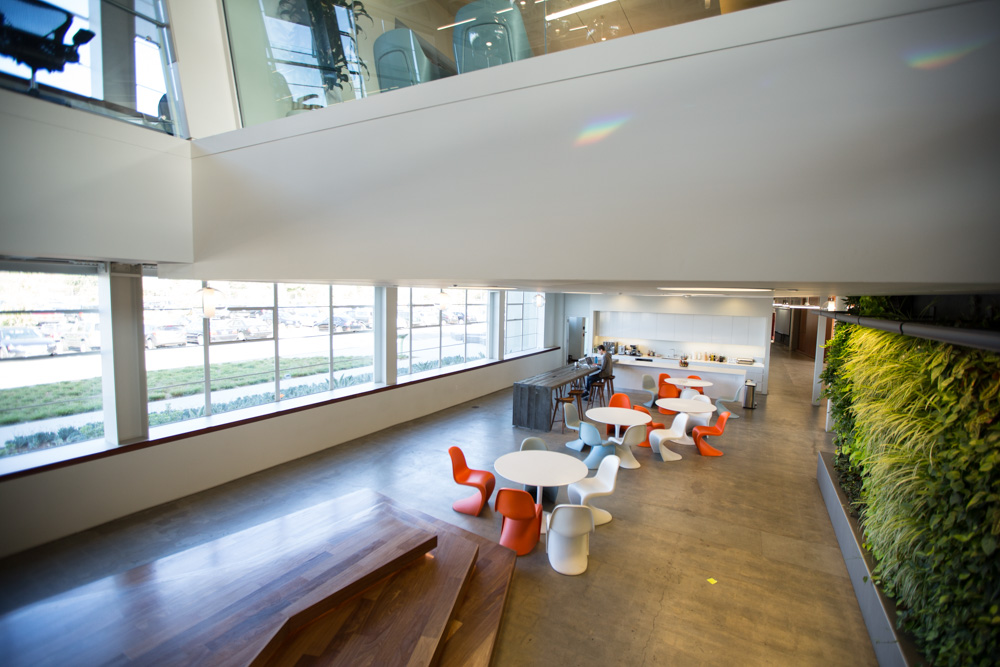
Since this is the boardroom, why not shape the table like a surfboard? The founders are all avid surfers, so the culture runs deep here at 72andSunny – being close enough to the beach, the facilities are optimized for surf breaks, racks to stash boards, and showers post-session.
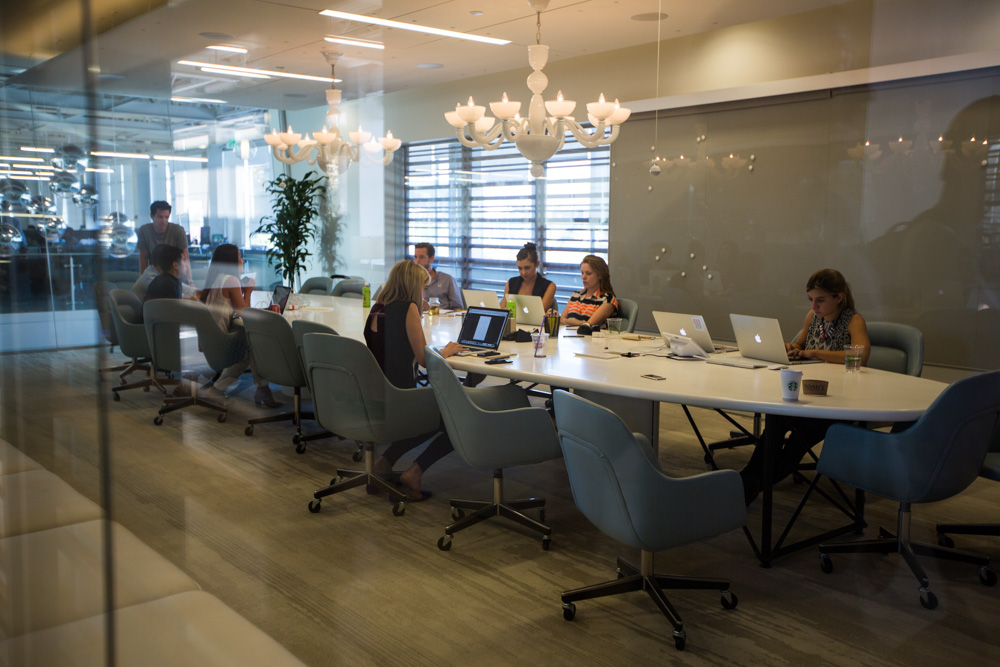
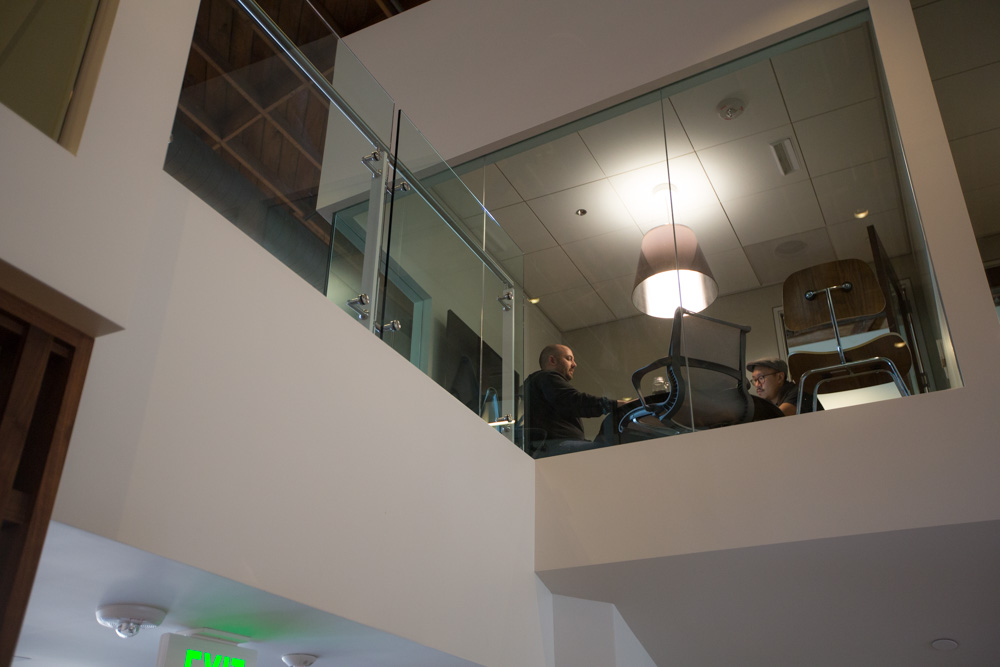
There are open kitchens for staff to take advantage of throughout the buildings, including free beer on tap, wine, and plenty of snacks.
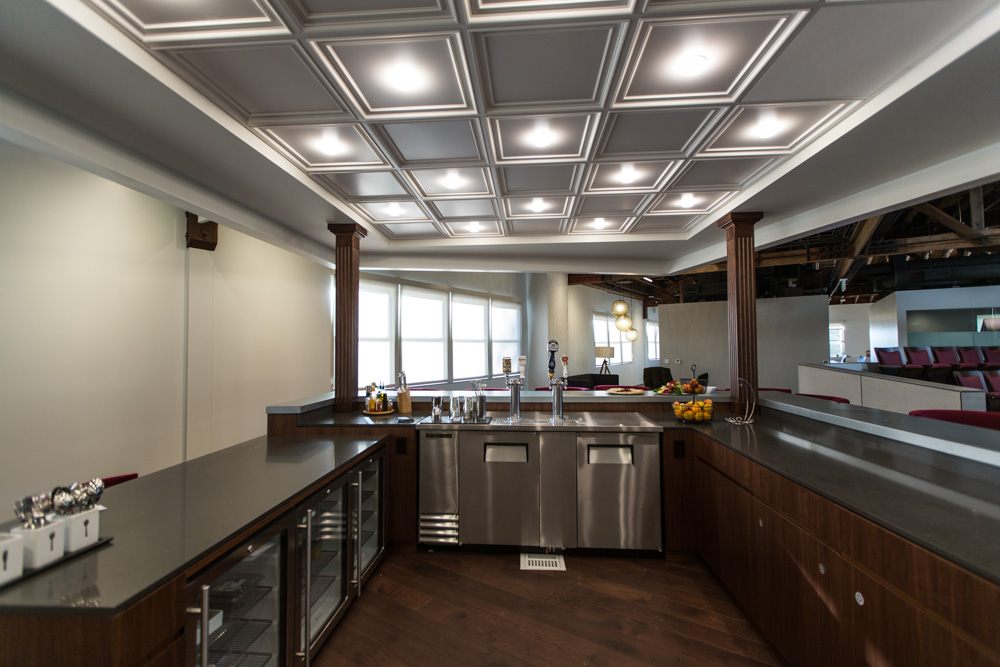
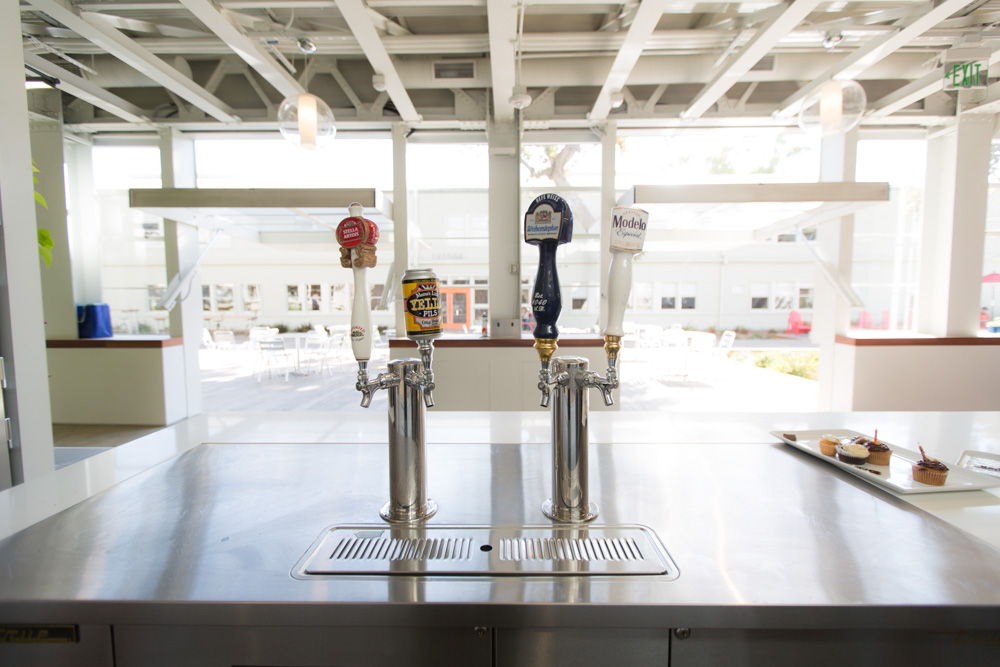
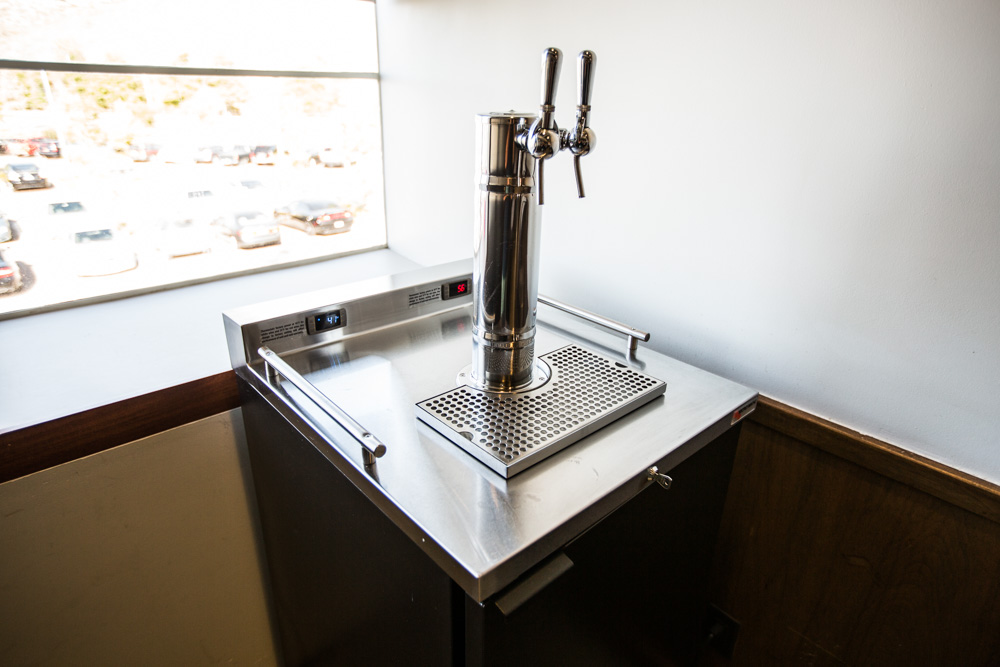
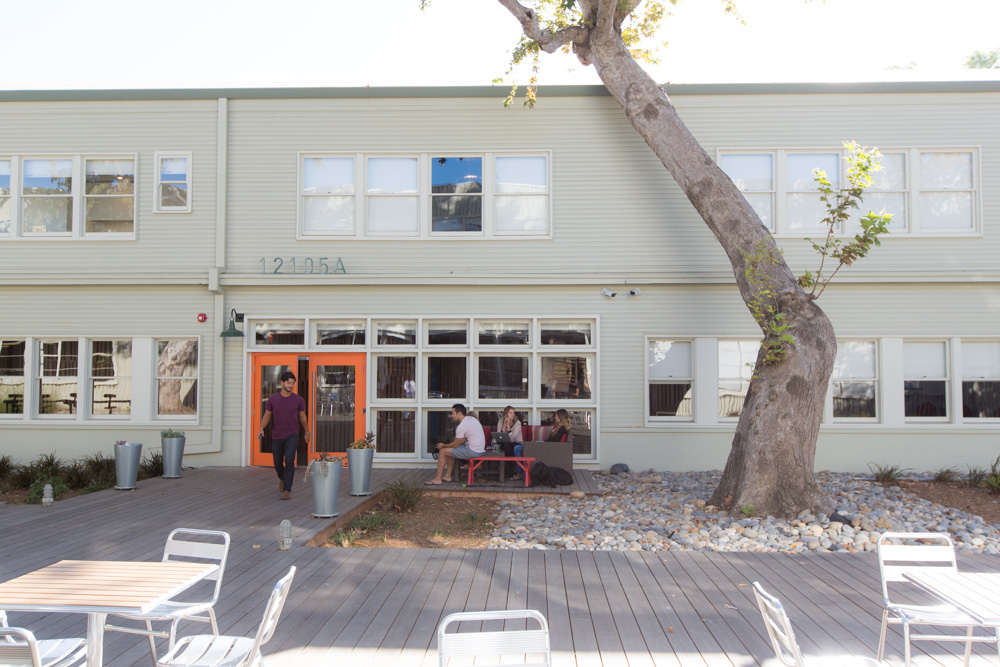
Playa Vista is an odd place to establish office complexes because of the marshy environment, but with 72andSunny here, video game companies surrounding, YouTube literally next door, this neighborhood is fast connecting to the larger Silicon Beach community, while feeling very NOT L.A.
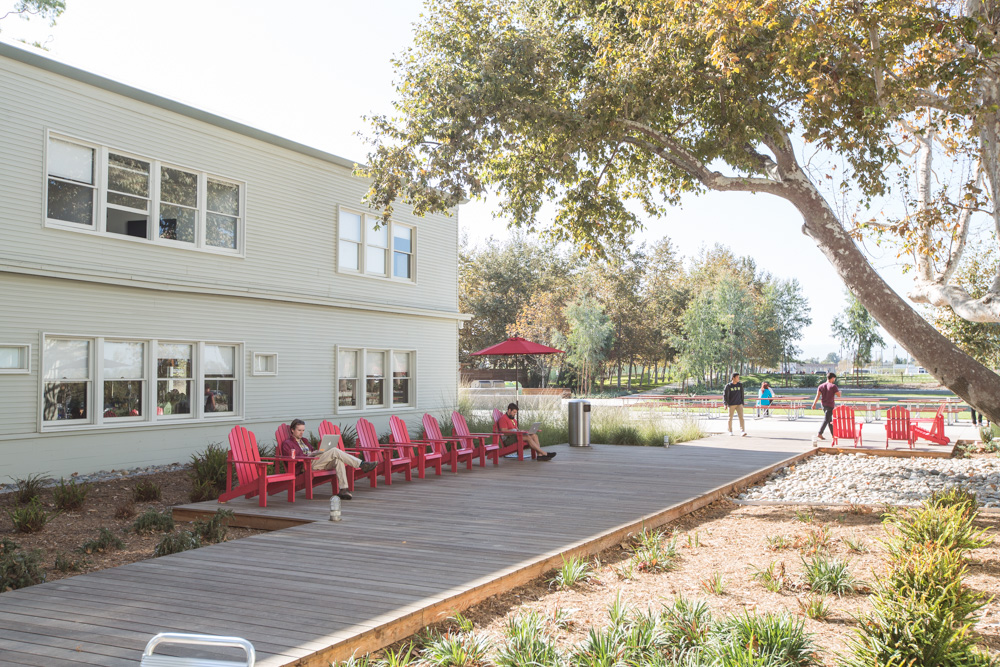
The new auditorium borrows found flooring from UCLA’s former basketball court.
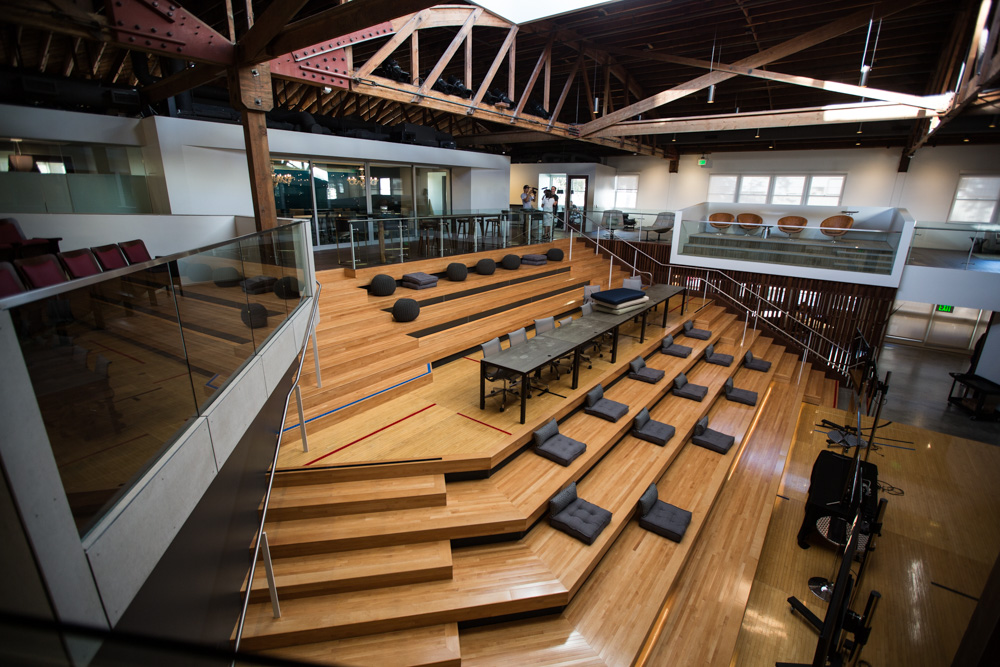
Video game breaks:
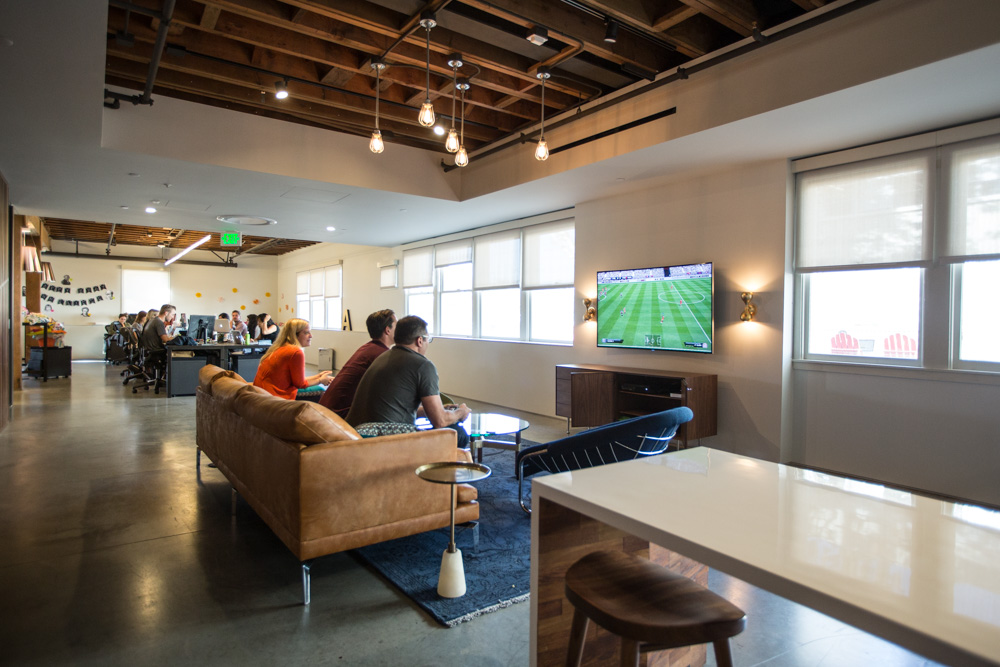
This is the media department. The rooms in the back are editing bays.
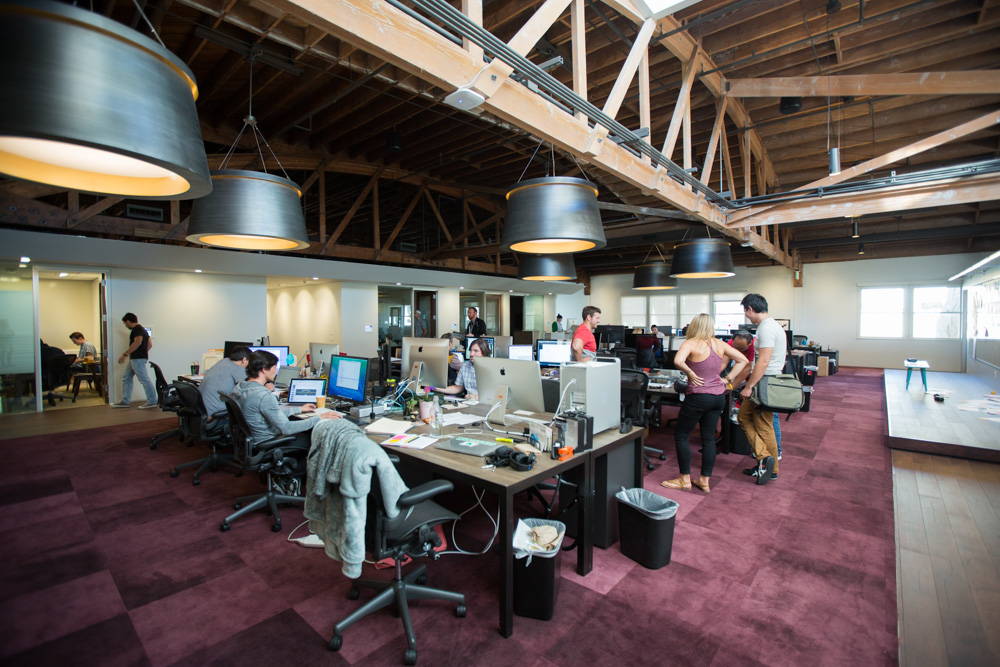
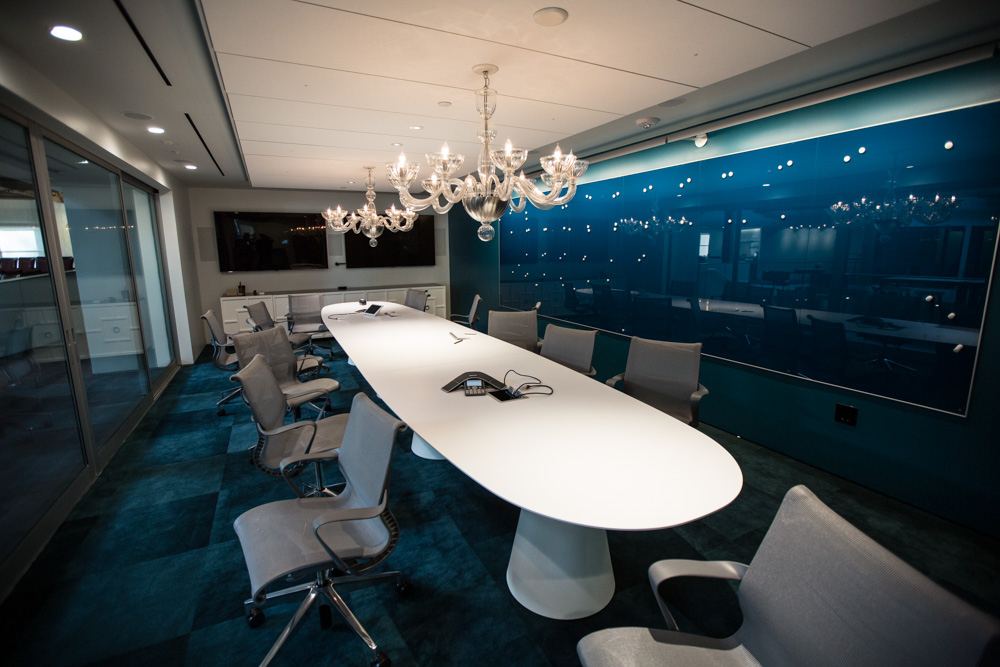
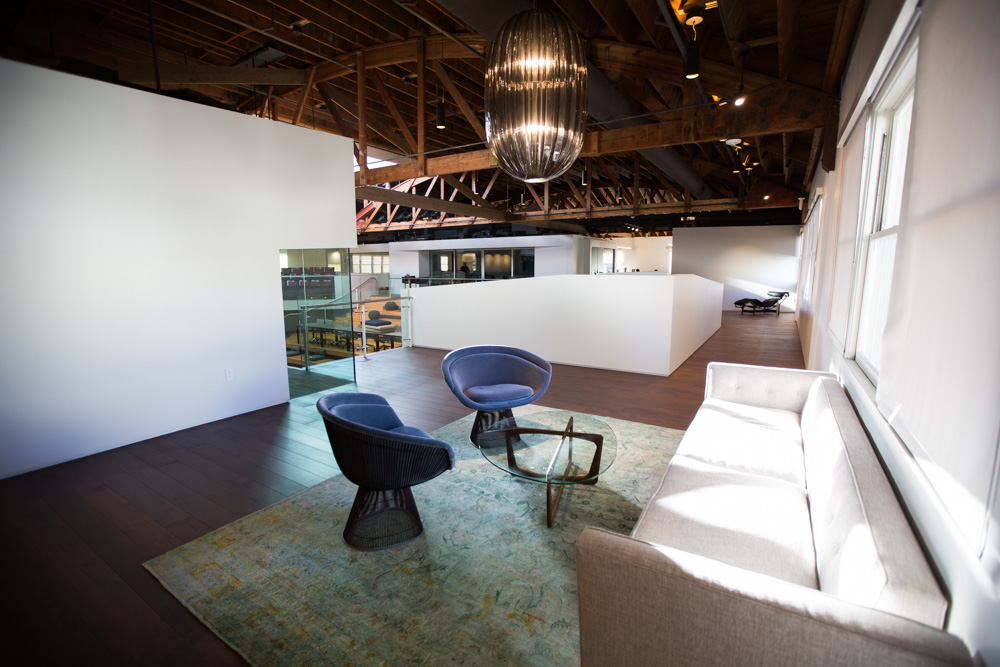
Showers and lockers are a big hit around here.
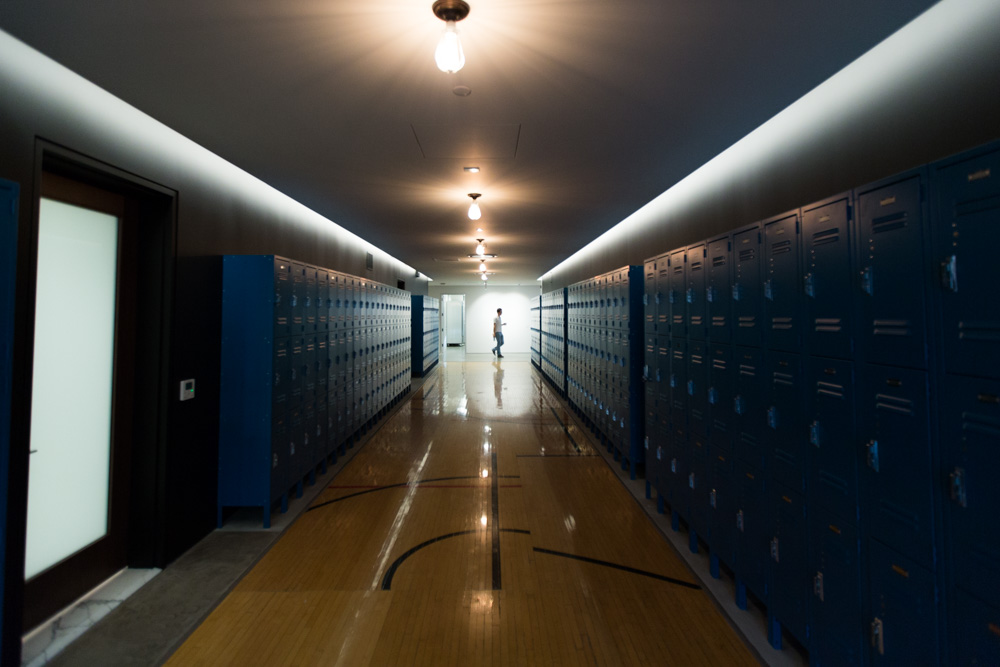
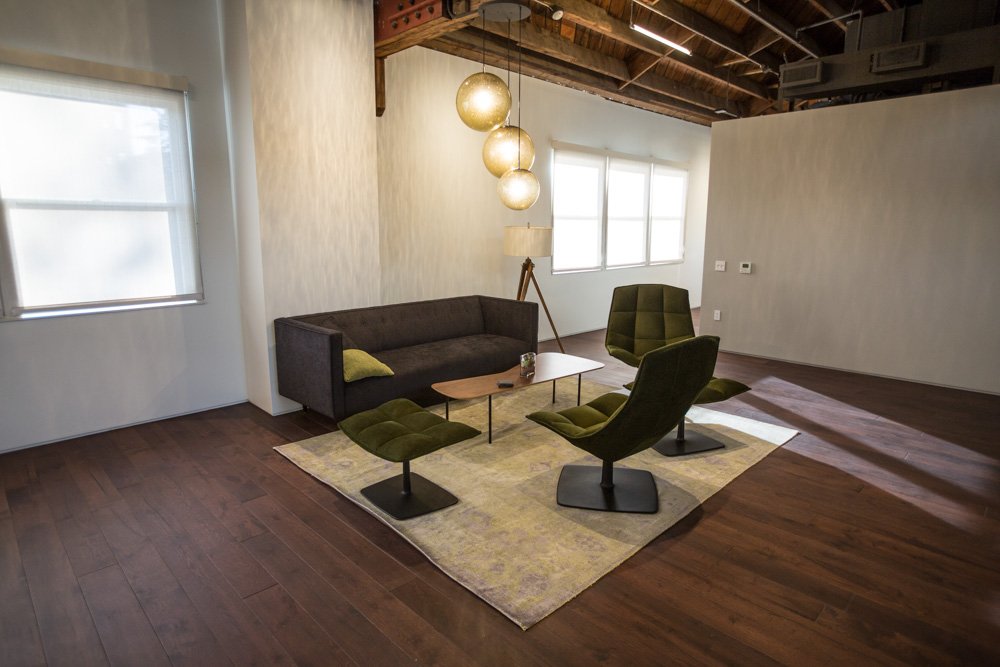
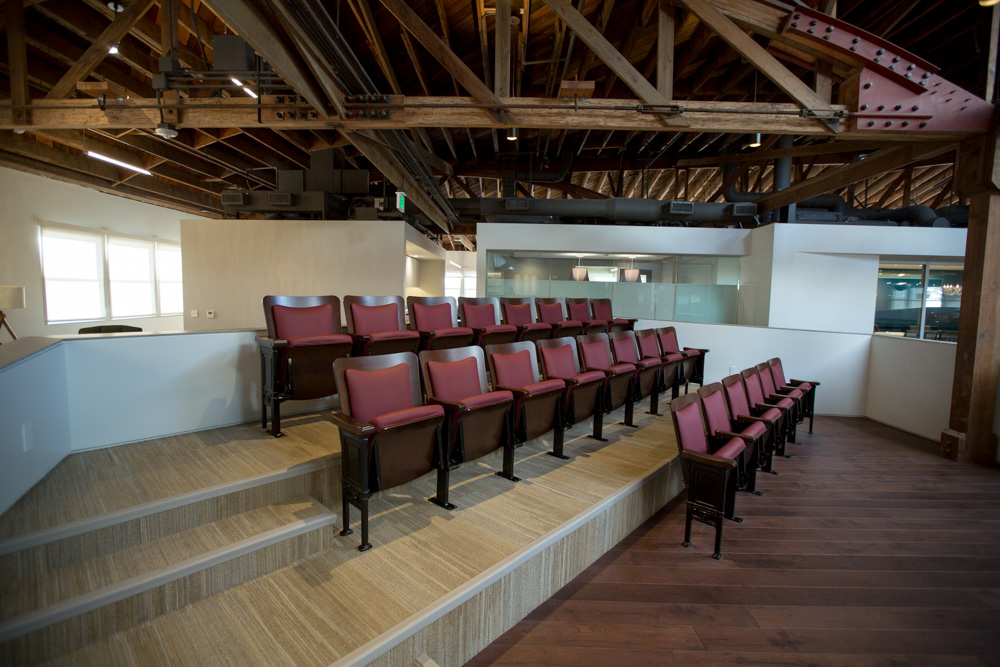
Back inside the vault. Acting as a pre-digital hard drive, every night Howard Hughes’ workers would return airplane blueprints they were working on here.
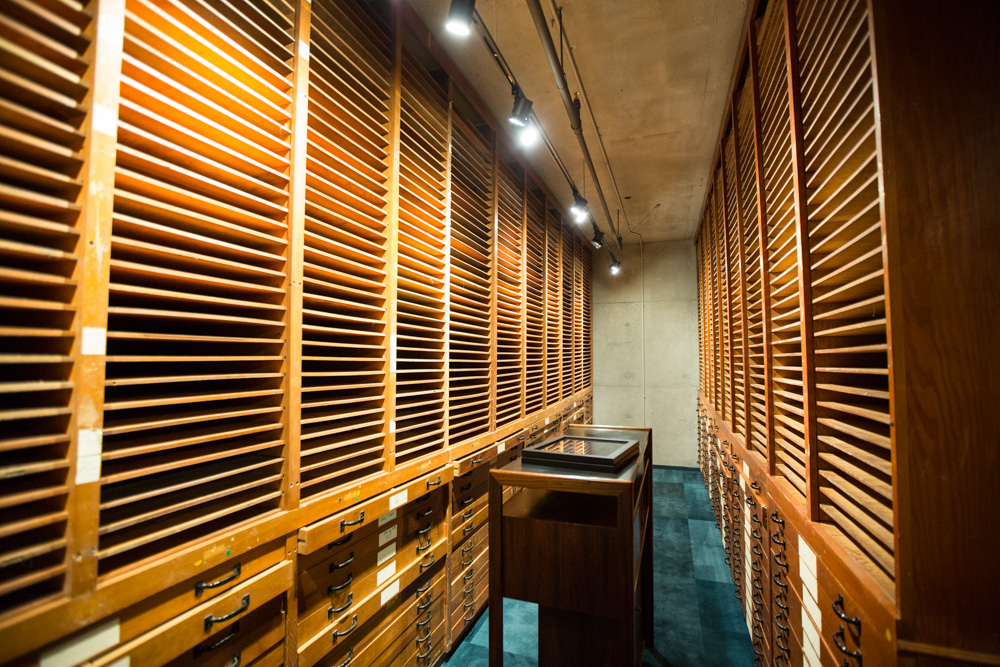
72andsunny, advertising agency, Howard Hughes,
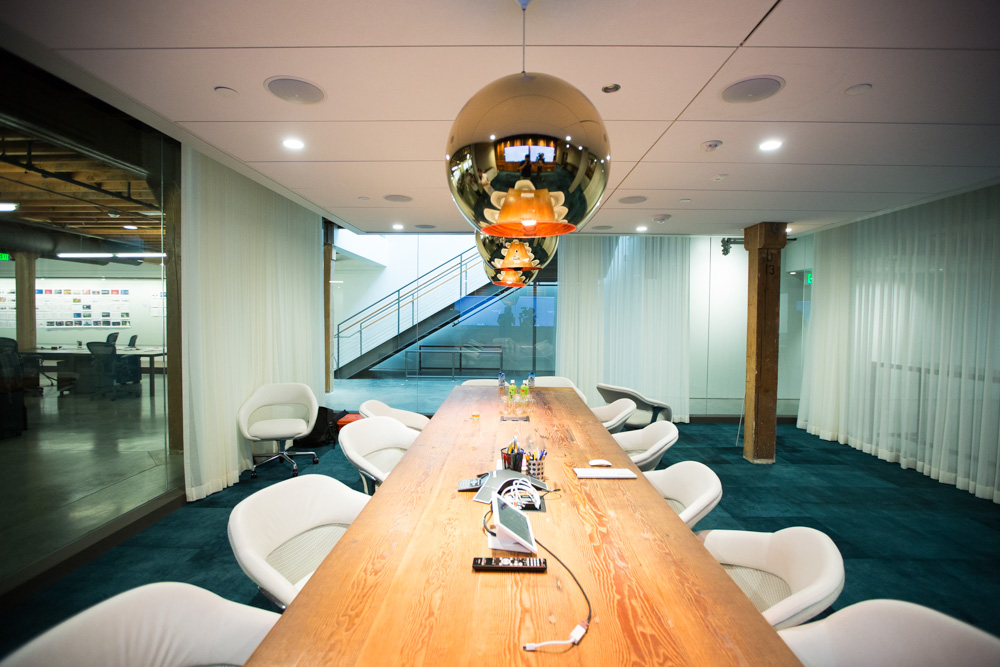
Thank you to Communications Coordinator Ginny Adams and my friend Nate Morley for all the help.
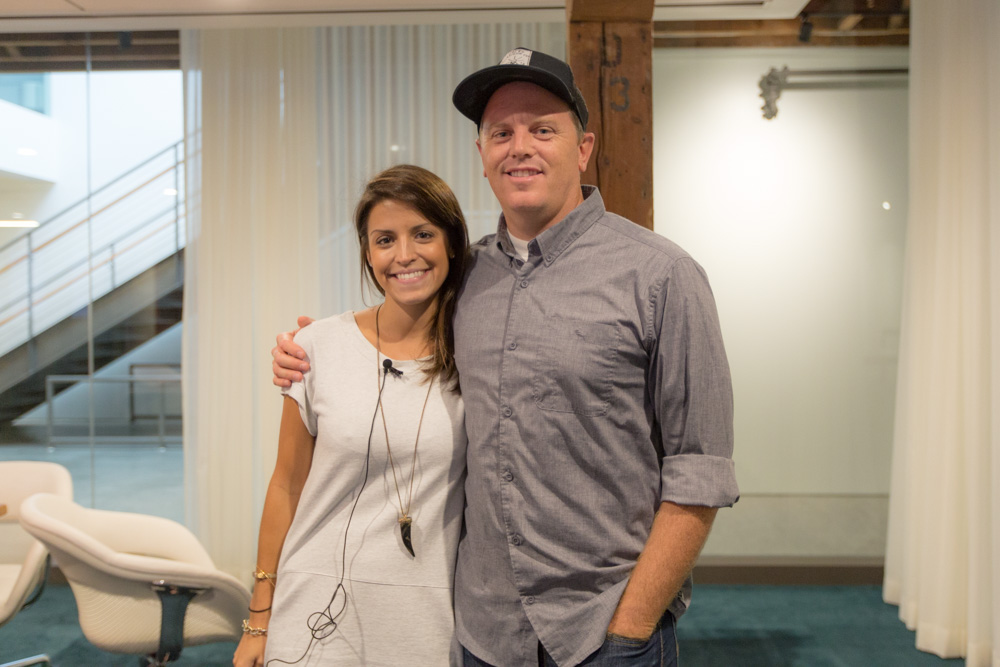
The only archived blueprint the guys found when moving into this building. Looking back, moving forward..!
